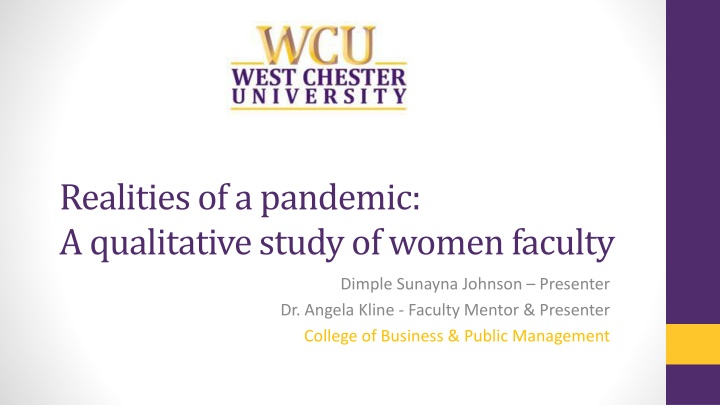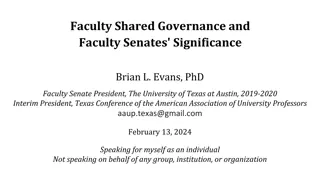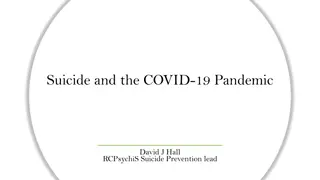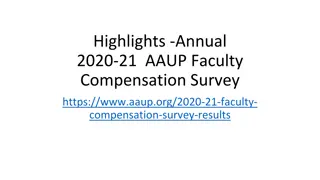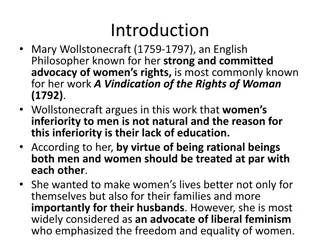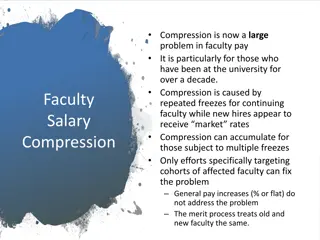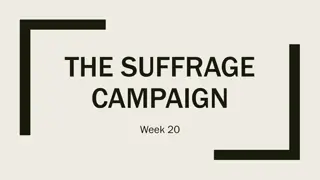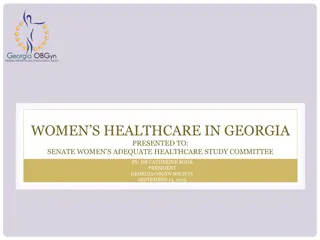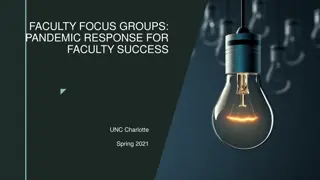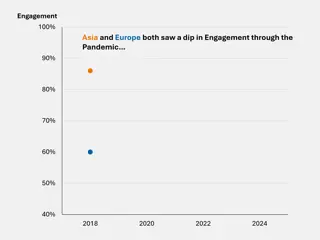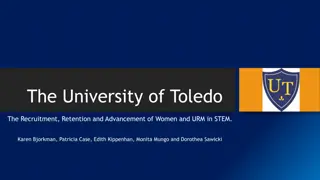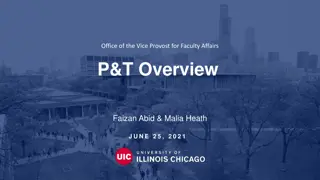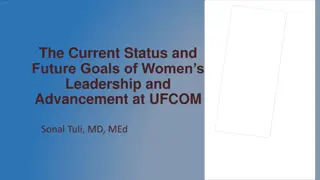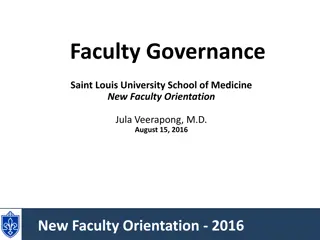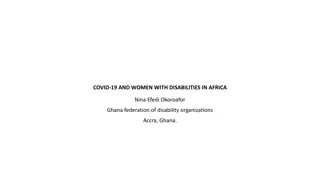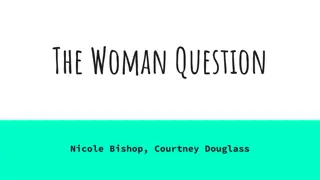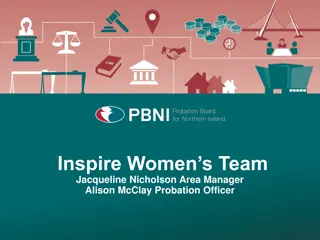Realities of a Pandemic: Women Faculty Study
This qualitative study delves into the experiences of women faculty in higher education during the COVID-19 pandemic, exploring their stress levels, support systems, and caregiving roles. Through methodology, findings, and discussions, it sheds light on the challenges faced and potential implications for future research and support mechanisms.
Download Presentation

Please find below an Image/Link to download the presentation.
The content on the website is provided AS IS for your information and personal use only. It may not be sold, licensed, or shared on other websites without obtaining consent from the author.If you encounter any issues during the download, it is possible that the publisher has removed the file from their server.
You are allowed to download the files provided on this website for personal or commercial use, subject to the condition that they are used lawfully. All files are the property of their respective owners.
The content on the website is provided AS IS for your information and personal use only. It may not be sold, licensed, or shared on other websites without obtaining consent from the author.
E N D
Presentation Transcript
Realities of a pandemic: A qualitative study of women faculty Dimple Sunayna Johnson Presenter Dr. Angela Kline - Faculty Mentor & Presenter College of Business & Public Management
Overview Background & Significance Women Faculty in Higher Education Maslow s Hierarchy of Needs Methodology Findings Discussion Conclusion & Future Research Next Steps
Background & Significance Evolution of higher education environment Increased struggle for women Juggling work and home Onset of COVID-19 caregiving experience virtual lifestyle safer at home measures Purpose of the study understand & deduce workplace support and stress understand caregiving experiences
Women Faculty in Higher Education Stress feeling of being overloaded and out of control in an uncertain circumstance (Cohen et al., 1983) Emotional labor development, management, and performance of affective work (lawless, 2018, p. 86) Support exhibit lower levels of stress (Eisenberger et al., 2016) with organization support, especially in times of crisis (Rhoades & Eisenberger, 2002) Maslow s Hierarchy of Needs
Methodology Data Collection Opportunity sampling recruited using listserv and social media Confidential semi-structured virtual interviews Inclusion criteria: Full-time caregiving female faculty in Spring 2020 16 open-ended core questions and other associated questions Demographics Support Stress
Methodology -Sample Sample of 14 participants North America (n = 12); Europe (n = 2) Faculty-only role (n = 11); Faculty/administrator role (n = 3) Married (n = 12); In a relationship (n = 2) Child caregiving (n = 13); other caregiving (n = 1)
Methodology -Analysis Thematic analysis Holistic understanding, examining meaning Analysis post data collection Data segmented Preliminary analysis Adjusting themes Categorizing using Maslow s Hierarch of Needs
Findings External Sources of Support Institutional Concern for Students Emotional Labor Navigating Student Needs and Emotions Navigating Role Conflict Mom and Professor Limited Memory of that Time
Navigating Role Conflict Mom & Professor I was probably a bad mom. I think I did some shoddy parenting, but we have managed. What stands out to me is how hard it was to be present with my kids because it was just so stressful thinking about everything else. I knew as a mom all your kids want is for you to just play with them and be with them, but it's like you're so worried about everything else. It was really hard for me to just be a Mom who's not looking at my phone not worried about what's falling apart at work and just be there with them.
Navigating Role Conflict Mom & Professor With every single experience, it's a double-edged sword. It's either I'm feeling guilty because I was working. And, so therefore, you know, they had to do something for themselves [ ] if you say that to somebody who you know, they go, oh my god, she didn't make the kids lunch and it makes you feel so guilty. And to the other side of when I'm enjoying spending time with the kids, I'm then in the back of my head going, I should be doing this for the work. So, there's that constant guilt. I think is what I will never forget.
Discussion Physiological & Safety Needs No advancement to cognitive levels Balance between institutional criticism and understanding Asking for Help vs. Offering to Help Talk about it!
Conclusion & Future Research Ongoing mental health support for caregivers Processing the loss experienced during 2020-21 Continued Research on Caregiver Support Explore transition back to classroom
Next Steps Edit manuscript to incorporate feedback Submit manuscript to Review of Public Personnel Administration Follow-up study with women faculty on their return to the workplace
References Boncori, I. (2020). The never ending shift: A feminist reflection on living and organizing academic lives during the coronavirus pandemic. Gender, Work & Organization, 27(5), 677-682. Cohen, S, Kamarck, T., & Mermelstein R (1983) A global measure of perceived stress. Journal of Health and Social Behavior, 24(4), 385-396. Eisenberger, R., Malone, G. P., & Presson, W. D. (2016). Optimizing perceived organizational support to enhance employee engagement. Society for Human Resource Management and Society for Industrial and Organizational Psychology, 2, 3-22. Lawless, B. (2018). Documenting a labor of love: emotional labor as academic labor. Review of Communication, 18(2), 85-97. Lend k-Kab k, K. (2020). Women s work life balance strategies in academia. Journal of Family Studies, 1-19. Matud, M. P. (2004) Gender differences in stress and coping styles. Personality and Individual Differences,37(7), 1401-1415. Maslow, A. H. (1943). A theory of human motivation. In J. M. Shafritz & A. C. Hyde (Eds.), Classics of public administration (pp. 114-121). Cengage Learning. McLeod, S. (2007). Maslow's hierarchy of needs. Simply psychology, 1, 1-8. Nowell, L. S., Norris, J. M., White, D. E., & Moules, N. J. (2017). Thematic analysis: Striving to meet the trustworthiness criteria. International Journal of Qualitative Methods, 16(1), 1609406917733847. Rhoades, L., & Eisenberger, R. (2002). Perceived organizational support: A review of the literature. Journal of Applied Psychology, 87(4), 698-714. Safaria, T., Othman, A., & Wahab, M. N. A. (2012) Gender, academic rank, employment status, university type and job stress among university academic staff: A comparison between Malaysia and Indonesia context. International Journal of Humanities and Social Science, 1(18), 250-261. Sli kovi , A., & Ser i , D. (2011). Work stress among university teachers: Gender and position differences. Archives of Industrial Hygiene and Toxicology,62(4), 299-307. Tytherleigh, M. Y., Webb, C., Cooper, C. L., & Ricketts, C. (2005). Occupational stress in UK higher education institutions: A comparative study of all staff categories. Higher Education Research & Development, 24(1), 41-61. Wong, L. (2018, November 14) There s a stress gap between men and women. Here s why it s important. The New York Times. Yates, D. (2011). Researchers look for ingredients of happiness around the world. University of Illinois News Bureau. Life Sciences. Retrieved from https://news.illinois.edu/view/6367/205291 Zamarro, G., Perez-Arce, F., & Prados, M. J. (2020). Gender Differences in the Impact of COVID-19. Working Paper. https://tinyurl. com/CESRGenderDiffs.
